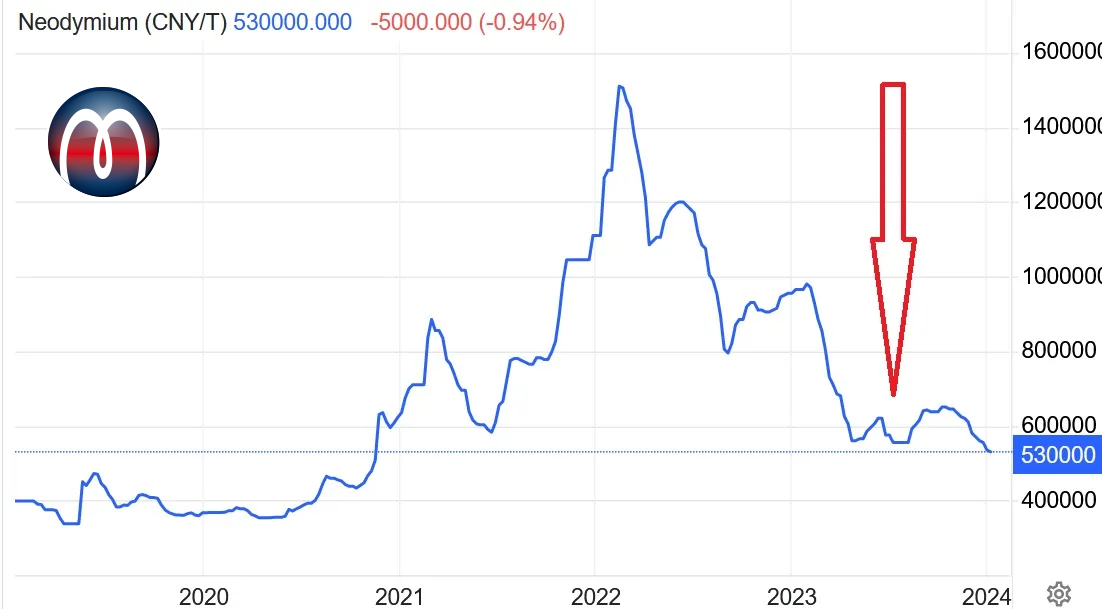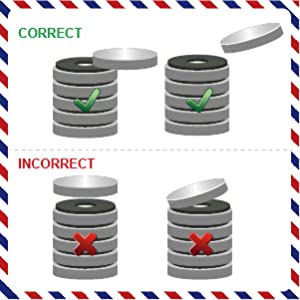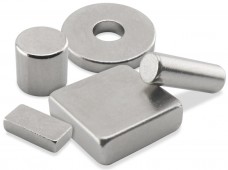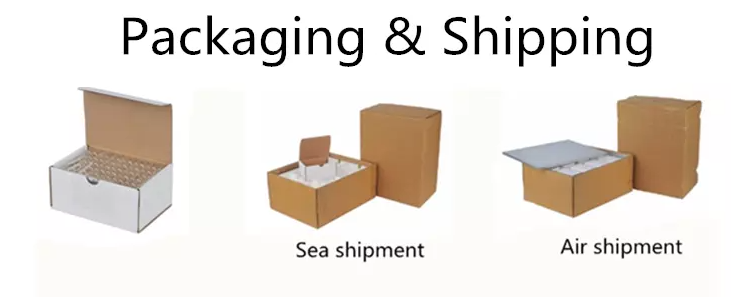 Price development for Rare-Earth Neodymium Magnets
Price development for Rare-Earth Neodymium Magnets
To minimize the effects of cost increases, Magnosphere recommends placing open orders as soon as possible, placing the goods in our stock, in order to obtain a final locked price that is not affected by the next increases. Thanks to partnerships with leading manufacturers, we are constantly monitoring developments in the situation and are committed to promptly inform our customers about market trends.
Below is the announcement of the quotations of the main raw materials used for the production of rare earth based magnets, indicated in RMB / Ton in the following graphs.
Neodymium price development since 2020 - as of 12-2024

We are happy to answer any further questions on this topic. If the price situation for neodymium magnets should change, we will inform you here as soon as possible.
Is the attraction between magnets as high as the repulsion?
The attraction between magnets is a little stronger than the repulsion. That is due to the alignment of the molecular magnets in the magnet. The attraction as well as the repulsion of magnets decrease significantly with increasing distance. The attraction as well as the repulsion of magnets decrease significantly with increasing distance. When two equal magnets touch each other, the attraction between two unequal poles is 5-10% stronger than the repulsion of equal poles. In a single magnet, the molecular magnets are aligned sort of parallel to each other.
Magnet Online Shop - Strong Magnets from Magnosphere
Where can you buy good, strong magnets? We answer all questions about strong permanent magnets competently. What is the plural of magnet? Magnet or magnets? Our Magnetshop has been serving the magnet community in providing stock & custom magnets for a wide range of industrial, commercial, technical & consumer applications to customers across the globe. We always carry a large inventory of permanent magnets; Neodymium Magnets, Ferrite Magnets, Samarium-Cobalt (SmCo), & Alnico Magnets AlNiCo available from stock for immediate shipment in a wide range of shapes, sizes & grades. We provide solutions for top companies in the world!
Description of magnetic materials
A magnet is a material or object that produces a magnetic field. This magnetic field is invisible but is responsible for the most notable property of a magnet: a force that pulls on other ferromagnetic materials, such as iron, steel, nickel, cobalt, etc. and attracts or repels other magnets. A permanent magnet is an object made from a material that is magnetized and creates its own persistent magnetic field. An everyday example is a refrigerator magnet used to hold notes on a refrigerator door. Materials that can be magnetized, which are also the ones that are strongly attracted to a magnet, are called ferromagnetic (or ferrimagnetic). These include the elements iron, nickel and cobalt and their alloys, some alloys of rare-earth metals, and some naturally occurring minerals such as lodestone. Although ferromagnetic (and ferrimagnetic) materials are the only ones attracted to a magnet strongly enough to be commonly considered magnetic, all other substances respond weakly to a magnetic field, by one of several other types of magnetism. Ferromagnetic materials can be divided into magnetically "soft" materials like annealed iron, which can be magnetized but do not tend to stay magnetized, and magnetically "hard" materials, which do. Permanent magnets are made from "hard" ferromagnetic materials such as alnico and ferrite that are subjected to special processing in a strong magnetic field during manufacture to align their internal microcrystalline structure, making them very hard to demagnetize. To demagnetize a saturated magnet, a certain magnetic field must be applied, and this threshold depends on coercivity of the respective material. "Hard" materials have high coercivity, whereas "soft" materials have low coercivity. The overall strength of a magnet is measured by its magnetic moment or, alternatively, the total magnetic flux it produces. The local strength of magnetism in a material is measured by its magnetization. An electromagnet is made from a coil of wire that acts as a magnet when an electric current passes through it but stops being a magnet when the current stops. Often, the coil is wrapped around a core of "soft" ferromagnetic material such as mild steel, which greatly enhances the magnetic field produced by the coil..
Permanent magnet
Many materials have unpaired electron spins, and the majority of these materials are paramagnetic. When the spins interact with each other in such a way that the spins align spontaneously, the materials are called ferromagnetic (what is often loosely termed as magnetic). Because of the way their regular crystalline causes their spins to interact, some metals are ferromagnetic when found in their natural states, as ores. These include iron ore magnetite or lodestone cobalt nickel, as well as the rare earth metals gadolinium and dysprosium (when at a very low temperature). Such naturally occurring ferromagnets were used in the first experiments with magnetism. Technology has since expanded the availability of magnetic materials to include various man-made products, all based, however, on naturally magnetic elements.
Composites
Ceramic, or ferrite, magnets are made of a sintered composite of powdered iron oxide and barium/strontium carbonate ceramic. Given the low cost of the materials and manufacturing methods, inexpensive magnets (or non-magnetized ferromagnetic cores, for use in electronic components such as portable AM radio antennas) of various shapes can be easily mass-produced. The resulting magnets are non-corroding but brittle and must be treated like other ceramics. Alnico magnets are made by casting or sintering a combination of aluminium, nickel and cobalt with iron and small amounts of other elements added to enhance the properties of the magnet. Sintering offers superior mechanical characteristics, whereas casting delivers higher magnetic fields and allows for the design of intricate shapes. Alnico magnets resist corrosion and have physical properties more forgiving than ferrite, but not quite as desirable as a metal. Trade names for alloys in this family include: Alni, Alcomax, Hycomax, Columax, and Ticonal. Injection-molded magnets are a composite of various types of resin and magnetic powders, allowing parts of complex shapes to be manufactured by injection molding. The physical and magnetic properties of the product depend on the raw materials, but are generally lower in magnetic strength and resemble plastics in their physical properties. Flexible magnets are composed of a high-coercivity ferromagnetic compound (usually ferric oxide) mixed with a plastic binder. This is extruded as a sheet and passed over a line of powerful cylindrical permanent magnets. These magnets are arranged in a stack with alternating magnetic poles facing up (N, S, N, S...) on a rotating shaft. This impresses the plastic sheet with the magnetic poles in an alternating line format. No electromagnetism is used to generate the magnets. The pole-to-pole distance is on the order of 5 mm, but varies with manufacturer. These magnets are lower in magnetic strength but can be very flexible, depending on the binder used.
Rare-earth magnets
Rare earth (lanthanoid) elements have a partially occupied f electron shell (which can accommodate up to 14 electrons). The spin of these electrons can be aligned, resulting in very strong magnetic fields, and therefore, these elements are used in compact high-strength magnets where their higher price is not a concern. The most common types of rare-earth magnets are samarium–cobalt and neodymium–iron–boron (NIB) magnets.
Single-molecule magnets (SMMs) and single-chain magnets (SCMs)
In the 1990s, it was discovered that certain molecules containing paramagnetic metal ions are capable of storing a magnetic moment at very low temperatures. These are very different from conventional magnets that store information at a magnetic domain level and theoretically could provide a far denser storage medium than conventional magnets. In this direction, research on monolayers of SMMs is currently under way. Very briefly, the two main attributes of an SMM are:
- a large ground state spin value (S), which is provided by ferromagnetic or ferrimagnetic coupling between the paramagnetic metal centres
- a negative value of the anisotropy of the zero field splitting (D)
Most SMMs contain manganese but can also be found with vanadium, iron, nickel and cobalt clusters. More recently, it has been found that some chain systems can also display a magnetization that persists for long times at higher temperatures. These systems have been called single-chain magnets.
Nano-structured magnets
Some nano-structured materials exhibit energy waves, called magnons, that coalesce into a common ground state in the manner of a Bose–Einstein condensate.
Rare-earth-free permanent magnets
The United States Department of Energy has identified a need to find substitutes for rare-earth metals in permanent-magnet technology, and has begun funding such research. The Advanced Research Projects Agency-Energy (ARPA-E) has sponsored a Rare Earth Alternatives in Critical Technologies (REACT) program to develop alternative materials. In 2011, ARPA-E awarded 31.6 million dollars to fund Rare-Earth Substitute projects.
Costs
The current cheapest permanent magnets, allowing for field strengths, are flexible and ceramic magnets, but these are also among the weakest types. The ferrite magnets are mainly low-cost magnets since they are made from cheap raw materials: iron oxide and Ba- or Sr-carbonate. However, a new low cost magnet, Mn–Al alloy, has been developed and is now dominating the low-cost magnets field. It has a higher saturation magnetization than the ferrite magnets. It also has more favorable temperature coefficients, although it can be thermally unstable. Neodymium–iron–boron (NIB) magnets are among the strongest. These cost more per kilogram than most other magnetic materials but, owing to their intense field, are smaller and cheaper in many applications.
Temperature
Temperature sensitivity varies, but when a magnet is heated to a temperature known as the Curie point, it loses all of its magnetism, even after cooling below that temperature. The magnets can often be remagnetized, however. Additionally, some magnets are brittle and can fracture at high temperatures. The maximum usable temperature is highest for alnico magnets at over 540 °C (1,000 °F), around 300 °C (570 °F) for ferrite and SmCo, about 140 °C (280 °F) for NIB and lower for flexible ceramics, but the exact numbers depend on the grade of material.
Units and calculations
For most engineering applications, MKS (rationalized) or SI (Système International) units are commonly used. Two other sets of units, Gaussian and CGS-EMU, are the same for magnetic properties and are commonly used in physics.
In all units, it is convenient to employ two types of magnetic field, B and H, as well as the magnetization M, defined as the magnetic moment per unit volume.
- The magnetic induction field B is given in SI units of teslas (T). B is the magnetic field whose time variation produces, by Faraday's Law, circulating electric fields (which the power companies sell). B also produces a deflection force on moving charged particles (as in TV tubes). The tesla is equivalent to the magnetic flux (in webers) per unit area (in meters squared), thus giving B the unit of a flux density. In CGS, the unit of B is the gauss (G). One tesla equals 104 G.
- The magnetic field H is given in SI units of ampere-turns per meter (A-turn/m). The turns appear because when H is produced by a current-carrying wire, its value is proportional to the number of turns of that wire. In CGS, the unit of H is the oersted (Oe). One A-turn/m equals 4π×10−3 Oe.
- The magnetization M is given in SI units of amperes per meter (A/m). In CGS, the unit of M is the oersted (Oe). One A/m equals 10−3 emu/cm3. A good permanent magnet can have a magnetization as large as a million amperes per meter.
- In SI units, the relation B = μ0(H + M) holds, where μ0 is the permeability of space, which equals 4π×10−7 T•m/A. In CGS, it is written as B = H + 4πM. (The pole approach gives μ0H in SI units. A μ0M term in SI must then supplement this μ0H to give the correct field within B, the magnet. It will agree with the field B calculated using Ampèrian currents).
Materials that are not permanent magnets usually satisfy the relation M = χH in SI, where χ is the (dimensionless) magnetic susceptibility. Most non-magnetic materials have a relatively small χ (on the order of a millionth), but soft magnets can have χ on the order of hundreds or thousands. For materials satisfying M = χH, we can also write B = μ0(1 + χ)H = μ0μrH = μH, where μr = 1 + χ is the (dimensionless) relative permeability and μ =μ0μr is the magnetic permeability. Both hard and soft magnets have a more complex, history-dependent, behavior described by what are called hysteresis loops, which give either B vs. H or M vs. H. In CGS, M = χH, but χSI = 4πχCGS, and μ = μr.
Caution: in part because there are not enough Roman and Greek symbols, there is no commonly agreed-upon symbol for magnetic pole strength and magnetic moment. The symbol m has been used for both pole strength (unit A•m, where here the upright m is for meter) and for magnetic moment (unit A•m2). The symbol μ has been used in some texts for magnetic permeability and in other texts for magnetic moment. We will use μ for magnetic permeability and m for magnetic moment. For pole strength, we will employ qm. For a bar magnet of cross-section A with uniform magnetization M along its axis, the pole strength is given by qm = MA, so that M can be thought of as a pole strength per unit area.
Fields of a magnet
Far away from a magnet, the magnetic field created by that magnet is almost always described (to a good approximation) by a dipole field characterized by its total magnetic moment. This is true regardless of the shape of the magnet, so long as the magnetic moment is non-zero. One characteristic of a dipole field is that the strength of the field falls off inversely with the cube of the distance from the magnet's center. Closer to the magnet, the magnetic field becomes more complicated and more dependent on the detailed shape and magnetization of the magnet. Formally, the field can be expressed as a multipole expansion: A dipole field, plus a quadrupole field, plus an octupole field, etc. At close range, many different fields are possible. For example, for a long, skinny bar magnet with its north pole at one end and south pole at the other, the magnetic field near either end falls off inversely with the square of the distance from that pole.
Electromagnets
An electromagnet, in its simplest form, is a wire that has been coiled into one or more loops, known as a solenoid. When electric current flows through the wire, a magnetic field is generated. It is concentrated near (and especially inside) the coil, and its field lines are very similar to those of a magnet. The orientation of this effective magnet is determined by the right hand rule. The magnetic moment and the magnetic field of the electromagnet are proportional to the number of loops of wire, to the cross-section of each loop, and to the current passing through the wire. If the coil of wire is wrapped around a material with no special magnetic properties (e.g., cardboard), it will tend to generate a very weak field. However, if it is wrapped around a soft ferromagnetic material, such as an iron nail, then the net field produced can result in a several hundred- to thousandfold increase of field strength. Uses for electromagnets include particle accelerators, electric motors, junkyard cranes, and magnetic resonance imaging machines. Some applications involve configurations more than a simple magnetic dipole; for example, quadrupole and sextupole magnets are used to focus particle beams.
Neodymium is the strongest available magnet alloy at up to 52MGOe. The use of Neodymium results in smaller, more cost-effective magnet solutions replacing older materials like Alnico and Ceramic in many applications. Magnosphere.co.uk can help optimize performance and cost with Neo magnets in grades from 33 to 52MGOe and operating temperatures up to 230°C/446°F. Stock Neodymium magnets also available.
How to Safely Seperate Your Magnosphere Magnets?

CORRECT
- Slide one magnet off the top of the stack.
- Once off thestack,carefully start lifting the magnet.
- Lift the magnet to free it from the stack.
INCORRECT
- DO NOT attempt to pull, lift, or pry amagnet from the stack before sliding it to the side.
- DO NOT throw away the white storage spacers.
- DO NOT allow the magnets to snap to each other or any magnetic surface. doing so may cause magnets to break!
Available Grades of Neodymium:
Many grades of Neodymium exist to support a variety of industrial and commercial applications. The range of Neo grades is typically 33 to 52 MGOe. These ranges allow for balancing cost, magnetic performance, and operational temperature resistance.
Many grades of Neodymium magnets exist to support a variety of industrial applications. The range of Neo grades typically extends from 33 MGOe to 52 MGOe. This range allows for optimizing cost, performance, and operational temperature resistance.
The typical convention for “Grade” is to use the value of the particular magnet alloy’s Energy Density or Maximum Energy Product. Oftentimes there are letters or a two digit number suffix attached to the Grade which indicates the Intrinsic Coercive Force (Hci) level of the magnet alloy. This Hci is a good indicator of the maximum allowable temperature a particular Neo alloy can tolerate before irreversible demagnetizing occurs.
The higher the “Grade number” then the higher the Energy Density. Usually the higher the Energy Density the stronger the magnet, but this is very much dependent upon the magnet’s operational environment.
Corrosion Resistance:
Neodymium magnets have poor resistance to corrosion and they can also corrode from the inside-out if proper pre-treatment processes are not followed. Oftentimes, multi-layer Nickel-Copper-Nickel plating is applied to prevent failure from corrosion, but this preventative technique may not be sufficient for all applications.
Corrosion Mechanism:
*Fully dense Neodymium Iron Boron is made with a powdered metal process. The quality of the powder dramatically impacts the resulting Neo magnet’s magnetic performance as well as environmental tolerance. Appropriately sized, well-formed powder grains which have little un-reacted constituent elements will result in highly performing magnets. Even magnets made with ideal powder will still have some un-reacted components which will oxidize or rust. (Poorly made magnets may oxidize from the inside out.)
Typically a corrosion preventive layer is applied in the form of a coating or plating. Because of the reactive nature of the NdFeB alloy, coating and plating adhesion is always a concern. Neo magnets are not coated or plated to a particular ASTM, ASM, etc. specification; however, the performance of a coating or plating is typically evaluated with a Salt Spray/Salt Fog Test (SST) and this is executed in accordance with ASTM B117.
The Neo alloy, magnet geometry, and corrosion inhibiting layer work in concert to extend the operational life of the magnet. Dura has compiled minimum performance characteristics of various coating and plating options for Neo magnets based on the ASTM B117 Salt Fog testing method. This method is only for evaluating Neo magnets which have a corrosion inhibiting layer.
Neodymium Magnets without coating or plating will fail immediately in the Salt Fog environment. The Salt Fog test is used to evaluate the performance of the plating or coating and it is not used to judge the quality of the Neo alloy itself. Various elevated temperature and humidity test can be used to evaluate the bare Neo alloy. The effective volume loss of the evaluated neo magnet is used to determine the quality of the neo magnet alloy. One compares the effective mass before and after the environmental testing exposure. (The “lost” volume is portion of the Neo alloy which reacted during the environmental testing and “rusted”. The rust/oxidation is removed from the sample and the resulting mass difference between the initial state is quantified.)
It is imperative to apply the correct corrosion inhibiting layer or to encapsulate any Neo magnet used in a commercial application. (The corrosion preventative layer can be absent for proof of concepts and prototypes.)
Please engage a Magnosphere application specialist for help with determining the best method for extending the operational life of the Neodymium magnet to be used in your application.
Temperature Effects:
Neodymium magnets are very susceptible to elevated operating temperatures and the application requirements should be considered before selecting a particular grade of Neo.
Neodymium Magnets are very susceptible to losing their effective magnetic field at elevated temperatures. The Neo magnet grade should be carefully selected to account for the operational temperature of the application and the magnet’s geometry. All magnet alloy will gain or lose effective magnetic field as the temperature flucuates. Neo magnets will lose effective field as the temperature increases and are said to have a Negative Temperature Coefficient. When compared to other magnet alloy options, neo magnets lose magnetic field at a faster rate. Neo magnets effectively have a higher Temperature Coefficient (TC) when compared to other commercial alloys.
This high rate of change relative to temperature exposure results in Neo magnets being very susceptible to demagnetizing from elevated operating environments. The magnet may be exposed to a temperature which does not fully demagnetize, but reduces its’ magnetic performance to a state that it no longer is able to provide sufficient magnet field to support the application.
The loss that has been discussed thus far is considered reversible. This means that the magnet will recover the loss as it cools back down. What is typically published by suppliers of magnets is the Reversible Temperature Coefficient (RTC) for each particular grade of Neo for both the Residual Induction (Br) and the Intrinsic coercive Force (Hci). The RTC as well as the recommended Maximum Operating Temperature must be considered when selecting a Neo magnet grade for an application above ambient room temperature.
Magnetization Options:
Although most commercial magnets are anistropic, which means they have a preferred direction of magnetization, various pole configurations can be achieved without conflicting with a Neodymium Magnet’s orientation.
Most useful commercial magnets are anisotropic which means that they have an “Easy” or preferred direction of magnetization and that an orientation field was applied during the compaction stage of the manufacturing process.
It is essentially impossible to magnetize the resulting anisotropic magnet alloy other than in the Direction of Orientation; however, various pole configurations can be achieved without conflicting with the magnet material’s orientation.
Compliance and Intellectual Property Considerations:
The Neodymium Iron Boron magnets that Magnosphere provides are compliant with Intellectual Property Rights, Environmental Restrictions, and Conflict Mineral usage.
- License Neo and compliant with the Neodymium Iron Boron (IP) holders.
- RoHS, RoHS II and REACH
- Dodd Frank Wall Street Reform Act (Section 1502)
Intellectual property rights exist for commercially viable Neodymium magnet alloys. Many infringing manufacturers from the Pacific Rim can offer cheap pricing because they pay no royalties to the patent holders, utilize substandard raw materials, and have poor Neodymium iron boron (also known as rare earth) magnet manufacturing methods. Utilization of infringing Neodymium magnets may lead to legal issues, delays, and product failures. Dura Magnetics, Inc. only provides licensed Neodymium magnet alloys which are traceable to the patent holders. This assertion of compliant Neodymium magnet alloy is supported by on-site inspections and contractual obligations initiated with alloy producers.
Handling and Storage of Neodymium Magnets:
Neodymium Magnets are very strong and brittle, requiring appropriate handling and packing to ensure safety and prevent damage.
Neodymium magnets are very strong and brittle and appropriate handling and packing is required. Most receiving departments are not familiar with the strength of neodymium magnets and this can result in injury or broken parts. All personnel that may come in contact with this alloy should be made aware of the dangers of handling these magnets. The brittle nature of the alloy can lead to flying chips if the magnets are allowed to impact each other or a solid surface. Larger magnets can become a pinching hazard if caution is not exercised. We urge all customers to discuss handling techniques pertinent to their magnets with a Magnosphere team member.
The packaging methods of neodymium magnetized alloys are dependent upon the magnet size and the customer requirement.
- Quarter-sized or smaller magnets are usually put attracting in rows. They may or may not have plastic spacers between them in order to reduce the attracting force between the magnets. These rows may be wrapped in corrosion inhibiting paper (VCI) and the wrapped rows are arranged attracting in a brick. The bricks may be skin packaged on cardboard or wrapped in foam.
- Magnets up to 2”square will be arranged attracting in rows with sizable spacers between each magnet. The rows can be arranged attracting with spacers running the length of the rows or individually wrapped in foam. Smaller quantities of these large magnets can go into an appropriate cardboard box, but larger volumes must be crated.
- Large magnets, arrays, or assemblies will be packaged in wooden crates. Many times these products must be shipped via a LTL carrier.
We are a UK company
Yes, we are a UK company proudly producing and supplying high-quality magnets to customers across the UK and world wide. At Magnosphere, we are offering a wide range of magnets, including powerful neodymium magnets, with fast shipping and excellent customer service. Whether you’re a business looking for bulk orders or an individual in need of specific magnets for a project, we are here to help with expert advice and tailored solutions.
 Supplier of Rare Earth Magnet, neodymium magnets and permanent magnets
Supplier of Rare Earth Magnet, neodymium magnets and permanent magnets
Our magnetic product assortment includes: disc magnets, ring magnets, magnetic spheres, block magnets, pot magnets, clamping magnets, car roof magnets, ceiling magnets, switching magnets, lifting magnets, flexible rubber magnets, sheet magnets, tape magnets, steel tape, notice boards, notice board magnets, magnetic paper, fridge magnets, business card conversions, magnetic sweepers, magnetic separation rod magnets, separator grids, compasses, gaussmeters, magnetic viewing film, iron filings, experiment kits, generator magnets, reed switch magnets, educational magnets.
We ship our Magnets worldwid via Sea or Air Shipment


Buy Powerful Neodymium Rare Earth Magnets at Magnosphere and get a better deal!
Magnosphere produces magnets at great prices, produced and delivered on time for all areas of industry, automotive, aerospace, electronics as well as in the design sector, trade fair construction, offices and for the home.
We are an ISO certified shop and carry the Trusted Shops seal. We have successfully completed more than 400,000 orders and offer our ever-growing customer base 24/7 customer service.
All items are available for immediate delivery in large numbers with daily dispatch. Our selection is your win! Thousands of satisfied customers! Buy from a company with the highest quality standards and customer service with flexible and diverse payment options and conditions.
We can also custom manufacture these to fit your exact specifications using our in-house global manufacturing facilities and team of experienced engineers. Need high quantities of magnets at the lowest and fairest price possible? Just let us know what you are looking for and contact our Customer Care Team by sending us a request for quote! We'll work with you to determine the most economical way of providing you with what you need.
Trust in our experience and convince yourself of our service and our products and we look forward to welcoming you to our magnet shop at Magnosphere. You are welcome to contact us by eMail: info(at)magnosphere.uk. Available 24/7 x 365 and we are also there for you on public holidays! Or just give us a call.
ROHS-Directive
![]() Magnosphere conforms to the RoHs directive and the Reach and PFOS regulations. Directive 2002/96 / EC of the European Parliament and of the Council, of January 27, 2003, on waste electrical and electronic equipment (WEEE).
Magnosphere conforms to the RoHs directive and the Reach and PFOS regulations. Directive 2002/96 / EC of the European Parliament and of the Council, of January 27, 2003, on waste electrical and electronic equipment (WEEE).

- Hotline:+44 (0)1138683670
- Telefax: +49.2241.9594520
- eMail: info@magnosphere.uk
We are very proud to offer excellent customer service. We know that without our clients, we would not be here. If you have any questions about your order or something else, please call or email us!: info(at)magnosphere.uk
24 / 7 x 365 Including holiday periods! Our customer service team is available to help you!

